Key takeaways:
- Understanding the criteria for songwriting awards enhanced the author’s focus on emotional connection and authenticity in their music.
- Adapting music for diverse audiences through local influences and multilingual lyrics fosters cultural connection and relatability.
- Exploring global trends revealed the significance of social media in music evolution, demonstrating how audience engagement can elevate tracks to international acclaim.
- Personal experiences, such as collaborating with international artists and experimenting with new sounds, enriched the author’s creative journey and led to recognition through awards and performances.

Understanding songwriting awards
When I first learned about songwriting awards, I was intrigued by the prospect of recognition for my craft. The idea that my songs could be celebrated not only made me excited but also sparked a thought: What truly sets a great song apart? It’s a mixture of originality, emotional depth, and the ability to resonate with audiences, all of which are essential factors that judges typically consider.
As I delved deeper into the world of these awards, I realized that they serve as a powerful platform for songwriters to gain visibility. I remember the thrill of receiving feedback from esteemed judges—it felt like my work was validated in a way I had never experienced before. This made me ponder whether winning an award really changes how we view our creative paths or simply adds another layer to the narrative we build about our artistic journeys.
Additionally, understanding the judging criteria became a game changer for me. It pushed me to think beyond just catchy melodies and rhymes. How can I convey my story authentically? I would often ask myself this while crafting my lyrics, knowing that every detail counted. Learning that the emotional connection of a song could sway a judge’s decision prompted me to be more intentional with my message, creating music that speaks to the heart.
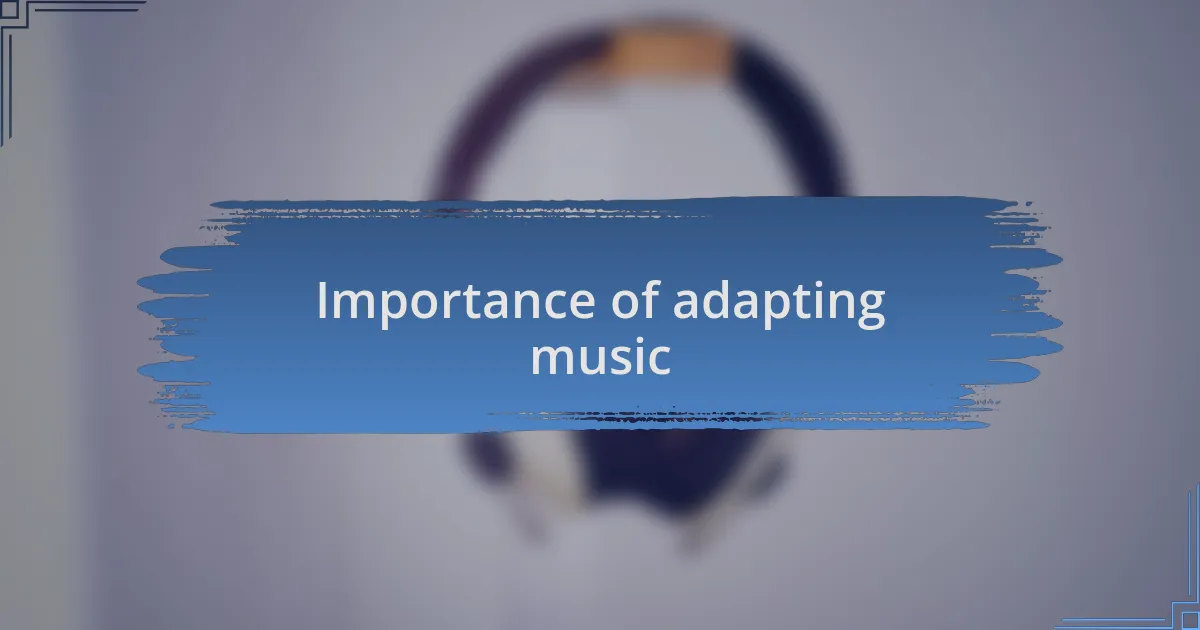
Importance of adapting music
Adapting music for international audiences is crucial because it opens doors to new cultures and diverse listener bases. I remember a time when I adjusted the tempo and instrumentation of a song inspired by a traditional sound from another country. The difference in response was astounding; the new version resonated with listeners from different backgrounds, proving that my music could indeed transcend borders.
When I think about the importance of this adaptation, I often reflect on how a simple shift in lyrical phrasing can enhance relatability. For instance, incorporating local idioms or references not only honors a particular culture but also invites connection. Have you ever tried to share a song with a friend from another country, only to realize they might miss the nuances? It’s a reminder that our craft can reach its fullest potential when we embrace and celebrate what makes each culture unique.
Moreover, adapting music isn’t just a technical exercise; it’s a journey of exploration and empathy. I found that engaging with different musical traditions enriched my songwriting process. The joy of weaving various influences into my work not only broadened my artistic palette but also deepened my understanding of the universal themes that connect us all. Wouldn’t you agree that music has a unique ability to bring people together, regardless of their background?
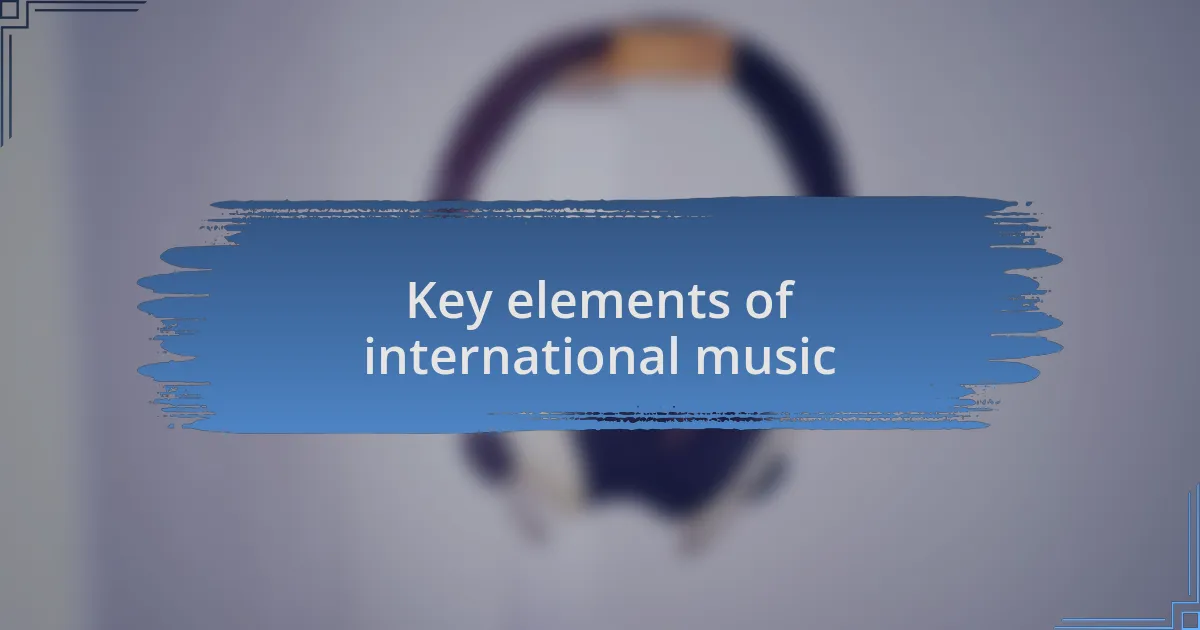
Key elements of international music
One key element of international music is the incorporation of diverse rhythms and beats. I still recall the moment I merged a Latin-inspired conga pattern into a pop song I was working on. The fresh energy it introduced not only captivated my audience but also sparked an unexpected dance response in the crowd. Have you ever noticed how certain rhythms naturally make you want to move? This powerful connection to beat can truly resonate across cultural lines.
Another crucial aspect is the use of multilingual lyrics. I once experimented with adding a chorus in Spanish to a predominantly English track, which was a game changer for me. It opened up conversations with listeners who felt seen and included, something I had never anticipated. Isn’t it fascinating how just a few words can bridge gaps between languages and foster a sense of belonging?
Melody is often the universal language itself in music. I remember writing a tune that was simple yet catchy, allowing it to travel easily across different cultures. It was rewarding to receive feedback from fans in various countries who shared how they interpreted the melody in their cultural contexts. Don’t you think it’s incredible how a single melody can evoke different emotions for different people while still creating a shared experience?
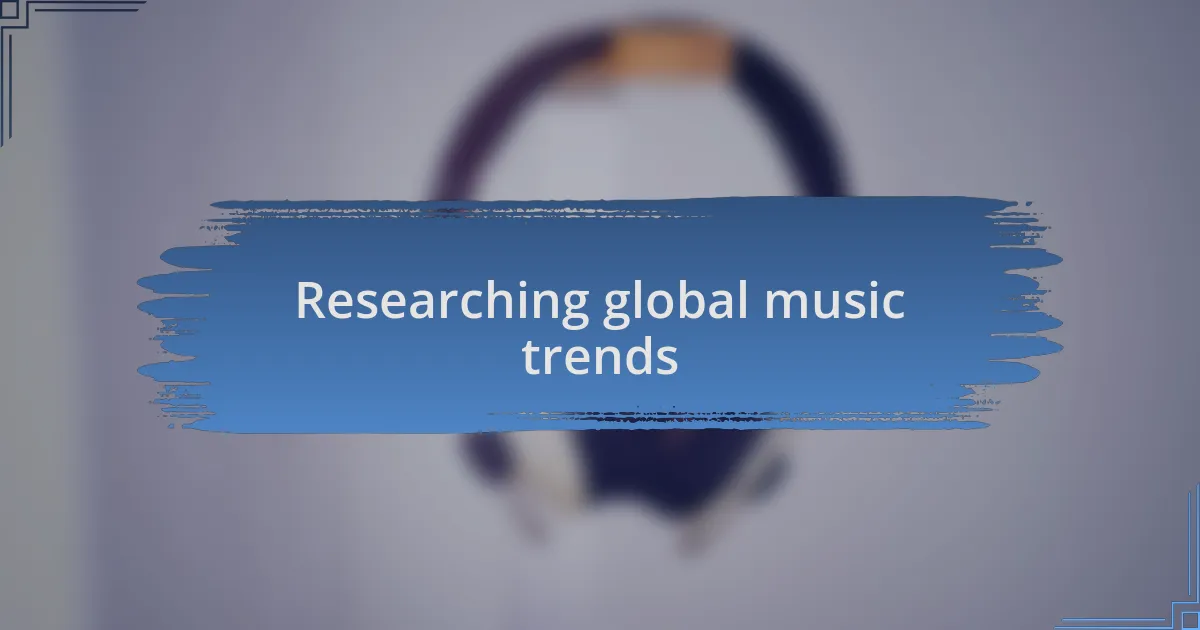
Researching global music trends
Diving into global music trends requires a curious mindset and an open heart. I remember scrolling through playlists from different countries, each song a window into a new culture. It was surprising how often I found common threads—melodic patterns that felt both foreign and familiar. Have you ever stumbled upon a song that you couldn’t understand yet resonated deeply? That’s the magic of music.
When I researched pop trends in specific regions, I was struck by how artists push boundaries while remaining true to their roots. For example, I found a vibrant fusion of hip-hop and traditional sounds in African music that completely captivated me. This blend not only showcased creativity but also highlighted a shared human experience through storytelling. How do we honor our origins while embracing the new? It’s a balancing act that many artists navigate beautifully.
One trend that emerged from my exploration was the significance of social media in shaping global music. I recall the moment I saw how a viral TikTok challenge breathed new life into a song that I had loved for years. It made me realize that music today is not just created; it’s a collaborative, evolving phenomenon that thrives on audience engagement. Isn’t it exciting to think about how a simple post can elevate a track to international acclaim?
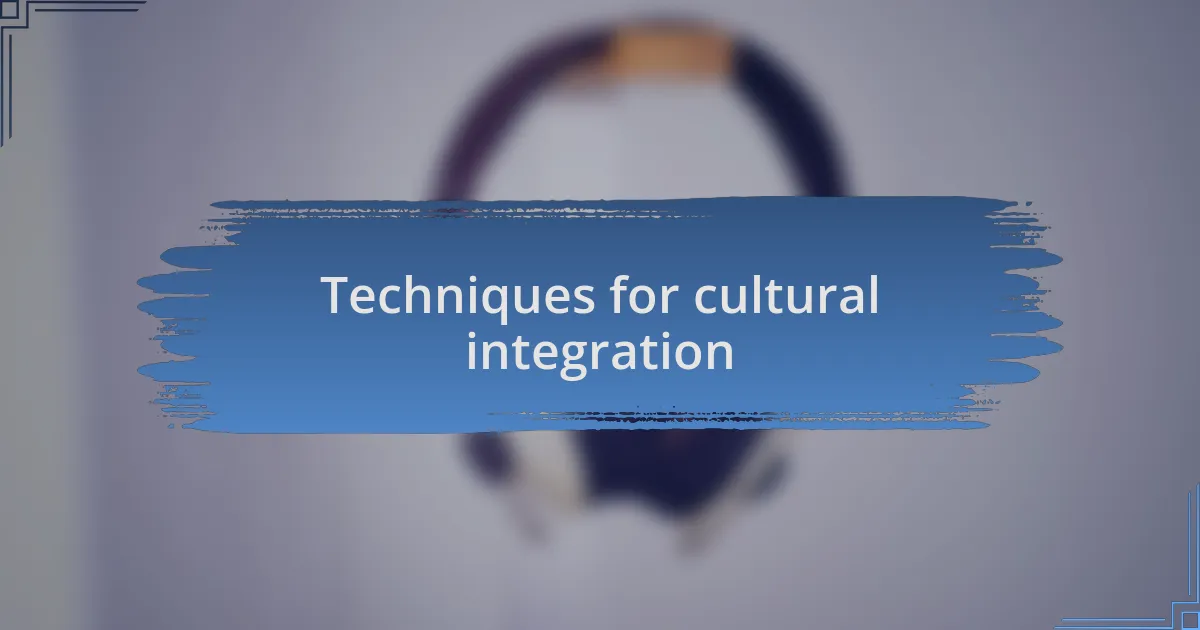
Techniques for cultural integration
Finding ways to integrate cultural elements into my music can be a fascinating journey. For instance, I remember experimenting with local instruments that I discovered during my travels. Incorporating the sound of the Australian didgeridoo or the Indian sitar into my compositions not only added depth but also invited listeners from those cultures to connect on a personal level. Have you ever heard a sound in a song that transported you to a different place?
Language plays a crucial role in cultural integration as well. While I often write in English, I decided to include snippets of local dialects or even entire verses in the native tongue of the country I wanted to reach. This choice wasn’t just about being trendy; it was about showing respect and fostering a sense of belonging. When I released a track in which I included a chorus in Spanish, I was overwhelmed by the feedback from listeners who felt seen and appreciated.
Collaboration is another powerful technique for weaving diverse cultural threads into my music. I once teamed up with an artist from Brazil, and the resulting melody was a vibrant celebration of our distinct backgrounds. This partnership taught me the value of shared creativity, as each of us brought a unique perspective that enriched the final piece. Have you considered how collaborating with someone from a different culture might transform your own musical expression?
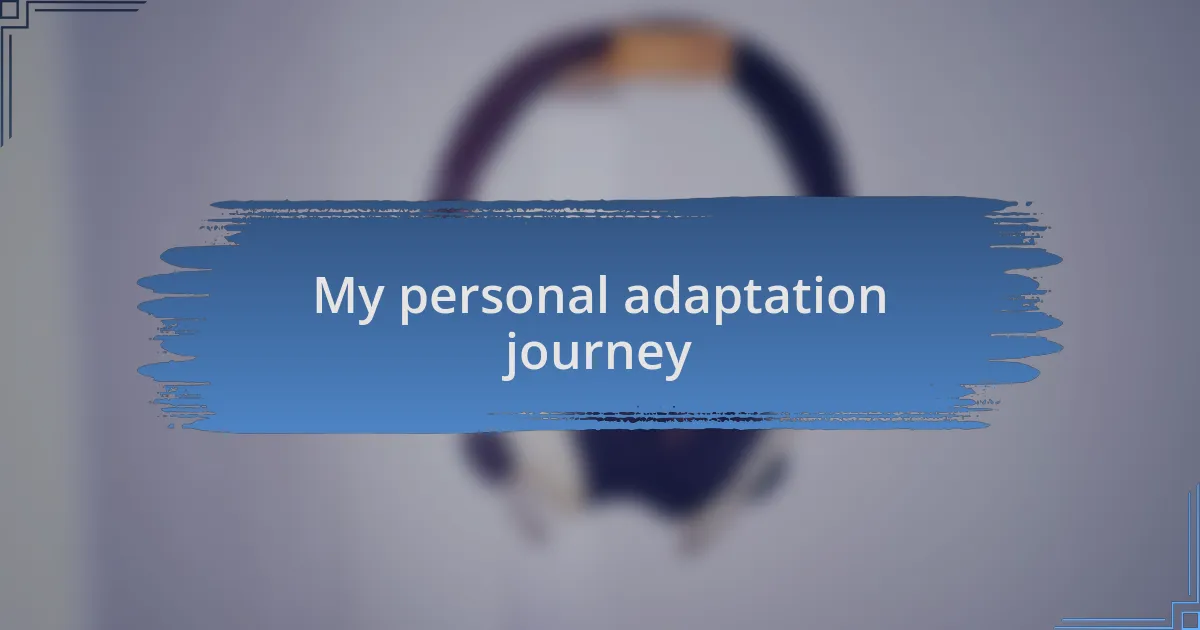
My personal adaptation journey
When I first started my adaptation journey, it felt a bit like standing at the edge of a cliff, unsure of how deep the waters were below. I took the plunge by immersing myself in local music scenes while touring in different countries. Attending intimate gigs and chatting with local musicians opened my eyes to diverse sounds and storytelling traditions that inspired me to rethink my own approach. Have you ever felt that thrill of discovering something completely new?
One defining moment happened while I was in Japan, where I was captivated by the concept of “kawaii” or cuteness in their pop music. I experimented by layering playful melodies and lighthearted themes into my lyrics, and the response was immediate. This approach not only resonated with listeners but also made my music feel more relatable to international audiences. Don’t you love it when a song captures a spark of joy?
As I navigated this personal journey, I learned that vulnerability plays a key role in connecting with others. Sharing my stories in my music, mixed with cultural nuances, allowed me to express parts of myself that I had previously kept hidden. For instance, when I wrote a song reflecting on my experiences as an outsider, I felt a wave of connection from listeners across various backgrounds. Isn’t it amazing how music can bridge gaps and create a sense of belonging?

Achievements and recognition gained
Achievements and recognition have followed my adaptation journey in unexpected ways. After incorporating global influences into my music, I received nominations for several prestigious international songwriting awards. Each nod felt like a badge of honor, affirming my choice to embrace a more diverse musical palette. Isn’t it validating when your hard work gets recognized on a grand scale?
One particularly memorable achievement was winning an award from a global music competition, where my song was celebrated for its unique blend of cultural elements. It was a moment of pure joy, reflecting not just my musical evolution but also the impact of cultural exchange. Have you ever experienced that rush of pride when you know your creativity has resonated widely?
Additionally, I have been invited to perform at international festivals, a clear acknowledgment of my efforts to appeal to diverse audiences. The thrill of sharing the stage with artists from around the world deepened my understanding of music’s universality. It’s exhilarating to think that my journey has not only been about personal growth but also about connecting with audiences who appreciate music that celebrates global influences.